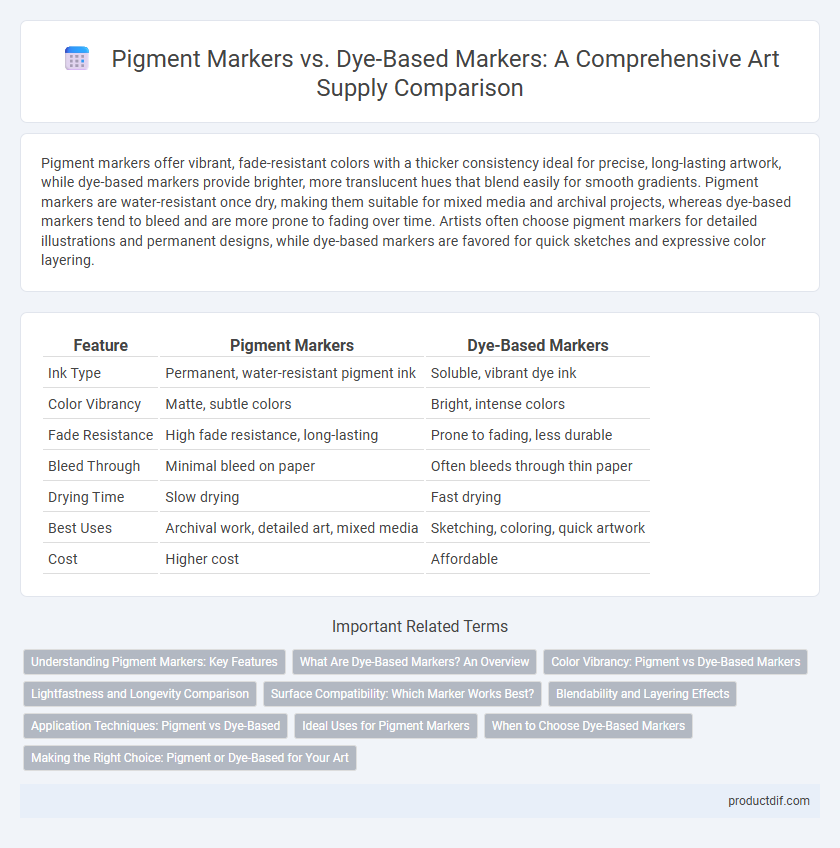Pigment markers offer vibrant, fade-resistant colors with a thicker consistency ideal for precise, long-lasting artwork, while dye-based markers provide brighter, more translucent hues that blend easily for smooth gradients. Pigment markers are water-resistant once dry, making them suitable for mixed media and archival projects, whereas dye-based markers tend to bleed and are more prone to fading over time. Artists often choose pigment markers for detailed illustrations and permanent designs, while dye-based markers are favored for quick sketches and expressive color layering.
Table of Comparison
| Feature | Pigment Markers | Dye-Based Markers |
|---|---|---|
| Ink Type | Permanent, water-resistant pigment ink | Soluble, vibrant dye ink |
| Color Vibrancy | Matte, subtle colors | Bright, intense colors |
| Fade Resistance | High fade resistance, long-lasting | Prone to fading, less durable |
| Bleed Through | Minimal bleed on paper | Often bleeds through thin paper |
| Drying Time | Slow drying | Fast drying |
| Best Uses | Archival work, detailed art, mixed media | Sketching, coloring, quick artwork |
| Cost | Higher cost | Affordable |
Understanding Pigment Markers: Key Features
Pigment markers contain finely ground pigments suspended in a binder, offering vibrant, opaque colors that resist fading and water damage. Their key features include lightfastness, permanence, and the ability to layer without bleeding or smudging, making them ideal for archival-quality artwork. These markers provide excellent coverage on various surfaces such as paper, canvas, and wood, enhancing durability and color stability over time.
What Are Dye-Based Markers? An Overview
Dye-based markers contain water-soluble dyes that soak into paper fibers, producing vibrant and translucent colors ideal for blending and layering. They often dry quickly but may bleed through thin or porous surfaces, making them suitable for sketching, coloring, and calligraphy on standard paper. These markers are favored for their bright hues and ease of use in flexible, creative applications like scrapbooking and detailed illustrations.
Color Vibrancy: Pigment vs Dye-Based Markers
Pigment markers offer superior color vibrancy with rich, opaque hues that sit on the surface of paper, ensuring bold and lasting artwork ideal for detailed projects. Dye-based markers, while often brighter initially, tend to absorb into paper fibers, which can cause colors to fade over time and appear less saturated. Choosing pigment markers enhances color intensity and permanence, making them a favored choice for artists requiring vivid, long-lasting results.
Lightfastness and Longevity Comparison
Pigment markers offer superior lightfastness compared to dye-based markers, ensuring artwork maintains vibrant colors over extended periods under exposure to light. The pigments' molecular structure resists fading and degradation, making them ideal for archival-quality projects and professional illustrations. Dye-based markers, while often brighter initially, tend to fade more quickly due to their soluble nature, limiting their longevity in long-term applications.
Surface Compatibility: Which Marker Works Best?
Pigment markers excel on non-porous surfaces like glass, metal, and plastic by providing opaque, long-lasting color that resists fading and smudging, making them ideal for professional art projects. Dye-based markers perform best on porous materials such as paper and fabric because their ink absorbs quickly, delivering vibrant hues but with less durability on slick surfaces. Choosing the right marker depends on the artwork's surface, with pigment markers favored for versatility and permanence, and dye-based markers selected for brightness and smooth blending on absorbent substrates.
Blendability and Layering Effects
Pigment markers offer superior blendability and layering effects due to their opaque, fast-drying ink that sits on the paper's surface, allowing artists to build rich, vibrant colors without bleeding. Dye-based markers tend to absorb into the paper, making smooth blending more challenging and often causing colors to mix unpredictably during layering. For techniques requiring precise gradients and multiple overlays, pigment markers provide greater control and durability in art supply choices.
Application Techniques: Pigment vs Dye-Based
Pigment markers offer superior lightfastness and opacity, making them ideal for layering, blending, and mixed-media techniques on various surfaces such as paper, canvas, and wood. Dye-based markers deliver vibrant, translucent colors that are excellent for smooth gradient effects, quick drying, and detailed line work, especially on porous surfaces like sketch pads and textiles. Artists often choose pigment markers for archival artwork, while dye-based markers suit projects requiring fluid application and bright intensity.
Ideal Uses for Pigment Markers
Pigment markers offer superior lightfastness and water resistance, making them ideal for archival artwork, scrapbooking, and mixed media projects where longevity is crucial. Their dense, opaque colors layer well on various surfaces including paper, wood, and fabric, enhancing detail work and vibrant effects. Artists prefer pigment markers for professional illustrations and fine art due to their fade-resistant properties and ability to create sharp, precise lines.
When to Choose Dye-Based Markers
Dye-based markers are ideal for artists seeking vibrant, translucent colors that blend smoothly on paper and fabric. These markers dry quickly, making them suitable for detailed work and layering techniques without smudging. Choose dye-based markers when working on porous surfaces or when you need a marker that absorbs well and achieves rich, glossy finishes.
Making the Right Choice: Pigment or Dye-Based for Your Art
Pigment markers offer vibrant, lightfast colors that resist fading and water, making them ideal for archival-quality artwork and mixed media projects. Dye-based markers provide bright, saturated hues with quick drying times, suitable for illustrations, fashion sketches, and work requiring smooth blending. Choosing between pigment and dye-based markers depends on whether durability or intensity and blending ease are the priority for your artistic style and medium.
Pigment Markers vs Dye-Based Markers Infographic

 productdif.com
productdif.com